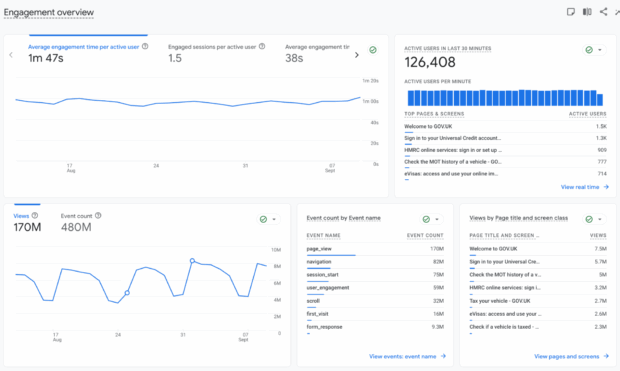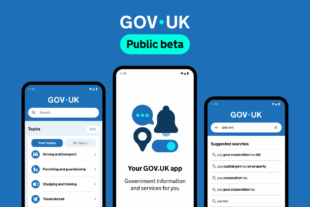
At GOV.UK, we use data and insights to help us design the best possible content and services for our users. Making the most of our data, collected with a user’s consent, is central to realising the vision set out in the blueprint for modern digital government.
Google Analytics is an important tool that enables us to understand how people use GOV.UK. Over the past few years, we’ve migrated from the previous version of this tool, Universal Analytics, to the current supported version, Google Analytics 4 (GA4). We’ve previously talked about our work upgrading to GA4, and the technical side of our implementation. Now, we want to reflect on a year of using the data, and where we want to go next.
How the last year has gone
In July 2024 the Government Digital Service (GDS) made the successful transition from Universal Analytics to GA4 with no interruption to service and a clean switch from old to new data collection. We had already been tracking page views in GA4 for nearly 2 years, and had at least a year’s data for the majority of our key events. We have more than 1,500 data analytics users across government, all of whom we managed to migrate to GA4 a few months before sunset. We had given critical users longer to familiarise themselves with the data via an early access group.
One thing we discovered during the migration is that the out-of-the-box GA4 interface would not directly meet many of our needs. We therefore adopted BigQuery as our primary platform for storing, processing and analysing our GA4 data, to enable high quality reporting and analysis. By enhancing our GA4 data with other datasets in BigQuery, we are able to uncover deeper insights about GOV.UK, such as analysing page visits against Google and internal site searches, or analysing traffic by content owner. BigQuery also allows us to customise reporting and metrics to our specific needs, enabling teams to quickly generate tailored insights and visualisations using tools such as Looker Studio. The insights we can gain from this allow us to build a much clearer picture of user behaviour on GOV.UK to help inform decision making at all levels.

Since we completed the migration, we have also moved from implementation to maintenance and continuous improvement. We have a healthy backlog of bug fixes and improvements we’d like to make to our web analytics offering, and maintaining the high quality of our GA4 implementation requires ongoing effort. To help with this, we developed a support model to manage our routine tasks as well as requests from GA4 users in GOV.UK. We’re hoping to roll this out to more teams within GDS in the coming months. We’ve also upskilled on Dataform, to improve the stability of our GA4 data pipelines, and are continuing to iterate our work with the help of a growing data engineering function in GOV.UK.
Where we’re going next
More than 100 products rely on GA4 data, such as GOV.UK’s search engine, the Content Data app, and a lot of our internal reporting. So, one of our primary goals is to ensure that this data remains as high quality as possible. We have developed a strategy for the next year that underpins our ambition to continually monitor, maintain and iterate our GOV.UK GA4 data. Google is also regularly releasing new features for GA4, so we’re keeping our eyes open for anything that can help us or our data users.
We are also thinking about governance and resilience across the team and the wider GDS. We’re currently working to ensure the right staff have the right skills to maintain our data collection and processing, and reduce bottlenecks.
With GOV.UK’s proposition expanding to new channels, we’ll be increasingly focussing on enabling cross-channel analysis, and we’re also looking for new ways to get more out of our data. We’re investigating how our work could be influenced by changes coming out of the Data (Use and Access) Act and are actively engaging with the Information Commissioner’s Office consultation on updating their guidance.
We are also increasingly mixing our GA4 data with other datasets such as our own GOV.UK polling, and content data sources, utilising a tool our data engineers are currently building, called a semantic layer. Our semantic layer will help to translate complex data into familiar terms, so people can easily understand and work with it without needing technical knowledge. This will really help to improve our ability to make data-driven decisions.
We’re really proud of how far we’ve come in this project. Equally, we know there’s still so much more value we can unlock from our web analytics data. We look forward to gradually delivering this to our users.
Subscribe to Inside GOV.UK to get the latest updates about our work.
 The GOV.UK app went live in public beta in July 2025. Find out what’s been happening, and what’s coming next,
The GOV.UK app went live in public beta in July 2025. Find out what’s been happening, and what’s coming next,
4 comments
Comment by Angela Moore posted on
I don't think this successful migration is celebrated enough. Congratulations to the team. I also love the sound of the 'semantic layer' - analytics data is getting more and more complicated, and it's great to see GDS finding ways to make this information more accessible to design teams and others.
Comment by PNP posted on
This is genuinely interesting. Would be nice to have some more detail on how gov.uk are using GBQ as GA4 is rather limiting when it comes to data collection and visualisation through GLS whereas GBQ is a much better source to store GA4 data. Would this be how GDS is mixing GA4 data with other datasets?
Can imagine that this migration project must have not been easy given its relatively tight deadlines and the sheer scale of gov.uk. Well done to GDS and the team behind this initiative.
Comment by The GOV.UK Insights and Analytics team posted on
Hi PNP,
Thanks for your comment. Yes, in BigQuery we combine processed GOV.UK GA4 data with other datasets, such as GOV.UK content metadata. We’re also taking advantage of features such as ‘views’, to make our data more efficient to query and store.
Thank you,
The GOV.UK Insights and Analytics team
Comment by Sebastian Moore posted on
Well done team!